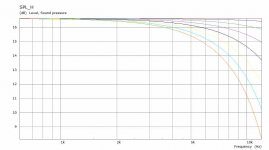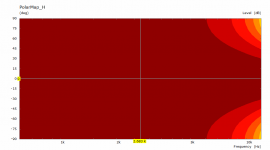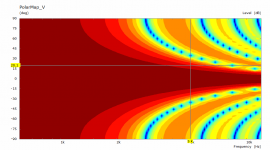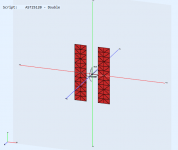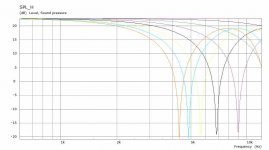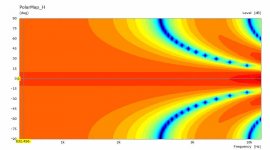I bet the side by side tweeters would be good for people who have to place their speakers almost against their side walls. Unless it shrinks the soundstage.
I like it worded as - narrows the polar...consider ribbon tweeters already have a narrow polar towards the top end to begin with. Duplicate tweeters side by side would exacerbate this
Here is the simulated directivity of a single ribbon/amt 25mm x 120mm vs a double with a 50mm gap. The single has very wide horizontal directivity still about 120 degrees pattern at 10K.
The double puts a couple of lobes in it.
Attachments
Flaxxer: what do you need/want/like? A well thought out list of requirements, priorities and 'no-gos' might be helpful to move forward.
Originally Posted by Flaxxer View Post
Desired spl ... 95 to 100db. 120db max
Desired Bandwidth ... 40 to 20
Listening distance ... 8ft
Size limitations.... under 6 feet tall
Desired Config .... 3 way, woofer with mid and high horns, or MTMWW
HIGH efficiency a must.
I'm thinking Pro Woofer, pro mid, and maybe AMT for highs.
Fluid just displayed more information about the Dave123 design than Dave123 has, himself. Trust the board Flaxxer....
- I have a hard time conceptualizing this as truth...what is your evidence? When you say "suboptimal" whats your definition of optimal for this application. I think 15" and 4" drivers can be great midranges yet 8" is a no go? I support what I've learned here from pretty much the best designers on the board, that the best mid is a 15".8 inch midrange is often suboptimal, unless it's a lower midrange (as often with a 4-way design).
Flaxxer is lacking leadership, probably due to inexperience in this field, there is no fault in that. There is a crazy amount of various paths he can take and get likely desirable results...
I think the tweeter is the most personal choice....there is a slight fork in the road when choosing tweeter power, in opinion. Pink noise vs white noise...one could base power needs around pink noise...one may be better off basing power needs around white noise...One usually makes sacrifices in design to get what they want.
If Flaxxer loves that Amt or any other Amt why not help him build a 3 way around it. His Chosen AMT tweeter + the biggest diameter mid allowing a proper xover point + a 15"..... not complicated. That is the formula for Scientific SQ, I don't really entertain the other forms of subjective SQ (open baffle).
The lower he can get his XO point on the tweeter, the bigger midrange he can use. This is the way to go unless he hits a wall that starts to sacrifice SQ of the tweeter passband. Flaxxer is a wood worker sounds like....He could potentially build a nice waveguide for his AMT tweeter which would be highly desirable.
After settling in on driver sizes, alls left to do is sift out the quality drivers for those sizes.....without a waveguide hes going to end up with a polar mismatch from tweeter to mid, but I think he has the means to craft one out of wood.
Last edited:
Doesn't a line array also have lobes, as would be the ribbon in the vertical dimension in the far-field?The double puts a couple of lobes in it.
https://engineering.purdue.edu/ece40020/Homework/SomeRefs/Line_Array_Theory.pdf
Desired spl ... 95 to 100db. 120db max
Desired Bandwidth ... 40 to 20
Listening distance ... 8ft
Size limitations.... under 6 feet tall
Desired Config .... 3 way, woofer with mid and high horns, or MTMWW
HIGH efficiency a must.
I'm thinking Pro Woofer, pro mid, and maybe AMT for highs.
I don't see how an AMT would work with a horn, so I am tempted to ignore the AMT idea.
That said, I'd say the OSMC would be a good fit. Maybe also take a look at the tower version.
"Speaker generating 90-93 dB at 1m with 1 W of power (around the sweet spot for high fidelity) will need an amplifier capable of +22-25 dB or 160-320 W (assuming my maths is OK)."
Where does this BS comes from?
When I place CD in my cd player, and use test disk with -3dB pink noise, and set volume to be moderately loud, I measure ~200mWatts of power on the speakers.
Where does +22 to +25 dB comes from?
My cd plater can not play more than 0dB. When I set it very loud, and recording reaches 0dB peaks from the cd player, I get 1 watt of power to the speakers. And that is loud.
Where does this BS comes from?
When I place CD in my cd player, and use test disk with -3dB pink noise, and set volume to be moderately loud, I measure ~200mWatts of power on the speakers.
Where does +22 to +25 dB comes from?
My cd plater can not play more than 0dB. When I set it very loud, and recording reaches 0dB peaks from the cd player, I get 1 watt of power to the speakers. And that is loud.
Speakers play 90 dB at 1 meter with 1 watt. If you wish to play 100 dB you need 20 dB extra. This corresponds to 100 watt amplifier power in this case. If you sit 3 meters away you need more if you will keep the 100 dB.
BS?
BS?
Yes 🙂
100-90 = 10
Also, most speakers are used in a room, not in outer space / 4pi conditions. Listening at 3m is therefore not so very different than at 1m.
Last edited:
Sorry, correct 10. 110 DB is 20 dB more. This is pretty loud and only needed at spikes in music.
I though that extra +20 to +25dB was needed because of the spikes in the music.
Since I play steady state signal at -3dB and is already loud, no need to go any louder, and only needs fraction of the watt, I have no need for 300 watts.
My objective was about the spikes! My DAC can only output certain signal, nothing more. There are no spikes beyond that.
Since I play steady state signal at -3dB and is already loud, no need to go any louder, and only needs fraction of the watt, I have no need for 300 watts.
My objective was about the spikes! My DAC can only output certain signal, nothing more. There are no spikes beyond that.
Adason, listening spot 3m away so it is your missing 9db.
Thr start hypothesis is 80dbspl at listening spot with 20db allowed for transient. Overall on peak you need 100db @ listening spot and then you add the 9db from distance loss.
Your -3db doesn't represent anything as you didn't specified a listening distance either dynamic range of signal ( with the impression to repeat myself, this 20db peak allowed is a worst case scenario as except from some very rare material you'll have less dynamic range ( pop is around 14db allowed, broadcast 12 db).
Thr start hypothesis is 80dbspl at listening spot with 20db allowed for transient. Overall on peak you need 100db @ listening spot and then you add the 9db from distance loss.
Your -3db doesn't represent anything as you didn't specified a listening distance either dynamic range of signal ( with the impression to repeat myself, this 20db peak allowed is a worst case scenario as except from some very rare material you'll have less dynamic range ( pop is around 14db allowed, broadcast 12 db).
Last edited:
...add the 9db from distance loss
Only of you are in free space. Most likely you are not.
Just play a pink noise signal in your listening room at 90 dB-SPL at your typical listening position and measure the electrical power output from your amp.
Why guys are you keeping on bringing room (acoustic) issues back into things which are loudspeaker related?
I did and still do use a calibrated system which is mandatory as i occasionaly work with my system ( and only comparison at a reference level can give you insight of what you are doing).
Why don't you get about the fact that for this reference level ( spl so average) to be possible with high dynamic range signal you'll need more power than with lower dynamics one?
I don't run my system full open all the time: i adapt level of signal for it to be 83dbspl at listening point with -20dbfs and with 20db dynamic range material it is far more higher than with lower one! ( everydoby know how to do a substraction so i won't explain it to you...).
There is nothing new or complicated about it.
Some 'people' from audio pro industry struggle to impose this view to others pro as this is the only way to make loudness war moot.
K-system - Wikipedia
Level Practices (Part 2) - Digido.com
And a list of records ( from 20db dynamic range to much less) and their needed level to have same perceived loudness:
Honor Roll - Digido.com
I did and still do use a calibrated system which is mandatory as i occasionaly work with my system ( and only comparison at a reference level can give you insight of what you are doing).
Why don't you get about the fact that for this reference level ( spl so average) to be possible with high dynamic range signal you'll need more power than with lower dynamics one?
I don't run my system full open all the time: i adapt level of signal for it to be 83dbspl at listening point with -20dbfs and with 20db dynamic range material it is far more higher than with lower one! ( everydoby know how to do a substraction so i won't explain it to you...).
There is nothing new or complicated about it.
Some 'people' from audio pro industry struggle to impose this view to others pro as this is the only way to make loudness war moot.
K-system - Wikipedia
Level Practices (Part 2) - Digido.com
And a list of records ( from 20db dynamic range to much less) and their needed level to have same perceived loudness:
Honor Roll - Digido.com
Last edited:
ok lets forget the acoustic issue for now
I did not specified details, which were not important
loud in my listening position is loud no matter how far it is
I still do not get it how can DAC already set to play -3dB produce +25dB spike
I am not talking about dynamic range of the music, my DAC can go from -3dB down to -120dB, way more than any music has the dynamic range
I just do not get that +25dB required
I know I do not need 300 watts amp, by experience, and by logic, when I play very loud, I measure 1 watt going to my speakers
Where is 300 watts coming from?
Your math is wrong
I did not specified details, which were not important
loud in my listening position is loud no matter how far it is
I still do not get it how can DAC already set to play -3dB produce +25dB spike
I am not talking about dynamic range of the music, my DAC can go from -3dB down to -120dB, way more than any music has the dynamic range
I just do not get that +25dB required
I know I do not need 300 watts amp, by experience, and by logic, when I play very loud, I measure 1 watt going to my speakers
Where is 300 watts coming from?
Your math is wrong
My math may be wrong but it is what is used by any acoustician to determine spl needed, or any PA engineer to give an spl garanteed at a listening distance ( what you get paid for in PA)... and between Andy's answer and mine to Diyiggy no need to repeat, just take every step one after another on a sketch and see by yourself if you didn't forget something along ( hint:i'm sure i didn't).
Maybe you use only amplifier with buffer stage in it but i doubt it... don't your amp have a voltage gain associated with it? And a max input voltage Adason?
Isn't your dac signal going to be amplified by something along the 20 to 36db inside the amp?
Maybe you use only amplifier with buffer stage in it but i doubt it... don't your amp have a voltage gain associated with it? And a max input voltage Adason?
Isn't your dac signal going to be amplified by something along the 20 to 36db inside the amp?
Last edited:
all your questions are not to the point I asked
lets leave it at that
off course there are gain stages, how is that relevant to my question
all I ask is this: put a test cd in your cd player
signal coming from your cd player is very high, already at -3dB, almost max
it goes to your preamp, amp, whatever, irrelevant
and now you set on your volume control at your listening position spl to loud
(it may be only 10% of loudness on you preamp, but its irrelevant)
theoretically, now cd player can only increase signal to 0dB
where is +25dB coming from...
lets leave it at that
off course there are gain stages, how is that relevant to my question
all I ask is this: put a test cd in your cd player
signal coming from your cd player is very high, already at -3dB, almost max
it goes to your preamp, amp, whatever, irrelevant
and now you set on your volume control at your listening position spl to loud
(it may be only 10% of loudness on you preamp, but its irrelevant)
theoretically, now cd player can only increase signal to 0dB
where is +25dB coming from...
25 dB is dynamic range out of speaker. It’s not comparable to 0 dB on CD player. You will never have 0 dB constant out of CD player. dB is just a scale that needs a reference point.
i know all that
I am asking, when you play white noise steady state signal from cd player at -3dB (I am referring to minus three dB below max signal of the DAC)
How can you from that jump +25dB spike
if 25dB if dynamic range of the speaker, that fine, that was not my question
but if that 25dB dynamic range speaker receives steady signal of white noise on top of its dynamic range (and consumes 1 watt)
now on the bottom of its dynamic range it is 25 dB quieter, and consumes significantly less power
where is 300 watts coming from?
I am asking, when you play white noise steady state signal from cd player at -3dB (I am referring to minus three dB below max signal of the DAC)
How can you from that jump +25dB spike
if 25dB if dynamic range of the speaker, that fine, that was not my question
but if that 25dB dynamic range speaker receives steady signal of white noise on top of its dynamic range (and consumes 1 watt)
now on the bottom of its dynamic range it is 25 dB quieter, and consumes significantly less power
where is 300 watts coming from?
"You will never have 0 dB constant out of CD player."
Where did I say that?
I am using test cd with -3dB white or pink noise
Where did I say that?
I am using test cd with -3dB white or pink noise
"dB is just a scale that needs a reference point."
I know that, I am referring to the max of the DAC, similar to any audio software for audio, I use Sony Soundforge
I know that, I am referring to the max of the DAC, similar to any audio software for audio, I use Sony Soundforge
Guys... First we tell him not to design his own speaker if he does not know what he is doing, so he finds some existing designs hr likes. Then we tell him the dave123 thing is no good, and he'd be better off to design his own speaker. Making him run in circles is not exactly helpful.
Flaxxer: what do you need/want/like? A well thought out list of requirements, priorities and 'no-gos' might be helpful to move forward.
I wasn't sure where to start responding since last night. I may have been frustrated some through the journey, but I will be okay. Working in the industry so long, taught me everyone does it "differently", and everyone else is "wrong".
No problem. I expected a LOT of opinions. I did not expect the veracity of the dialogue when disagreements are present. At least it has been civil for the most part.🙂
I wish I knew better how to describe what I am after. I have heard good horn systems, and enjoyed what they bring. Yet I've always heard what I consider a slight lack of refinement in the highs. So I chose a design that uses a known smooth CD when choosing the Asathor. THAT design goal is now covered ... Trying to get a "better" sounding Klipsch experience..
That leaves me with some money to spend. So I decided I would like to also have a higher efficiency speaker with more traditional drivers.
Does this work? "I'm after something like a good 3 way Revelator, Illuminator, Accuton, Aruum Cantus, etc but with more dynamics and efficiency"
Maybe in my ignorance, but I figured there was two ways to do this ... A lot of high end drivers to up the efficiency, or the rare Pro drivers that do well as HiFi drivers, paired with a more efficient and open high end. I'd prefer not spending thousands on 4 or more expensive drivers to up the sensitivity and dynamics.
I wish I knew better words or phrases to use than the above. But my latest tune hasn't changed in a long time. Pretty much since I walked away from the PBN idea.
- Home
- Loudspeakers
- Multi-Way
- I'm building a $4000 speaker kit ... Which one?
